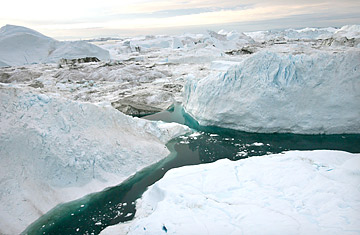
An aerial view of icebergs floating in the Jacobshavn Fjord, near the town of Ilulissat, Greenland
To a casual listener to global-warming skeptics, it would seem that climate scientists are foolishly professing to know exactly how climate change is playing out. But that's hardly the case: climate scientists have always maintained that their understanding of global warming — its future effects, how rapidly warming will occur, or to what degree — is far from 100%.
What they do know is that climate change is real, potentially dangerous and largely due to human activity. When it comes to the details, though, answers come in pieces — scientific journals publish studies almost daily, and each one helps narrow down the very real uncertainties that remain about how the planet responds to increasing levels of greenhouse gases.
A paper appearing in this week's Nature is a case in point. Scientists know that the Arctic is warming about twice as fast as the rest of the planet on average, a phenomenon known as Arctic amplification. And they have a pretty good idea of why: warmer temperatures lead to more meltback in sea ice in the summer, which exposes more ocean water. The water, which is darker and less reflective than ice, absorbs energy, heats up and warms the air in turn, leading to even more melting. It's a classic feedback loop, and it makes all sorts of sense — but a logical theory is not the same as proof.
The new Nature paper goes a long way toward firming up the case. By analyzing and comparing temperature records from all available sources over the past 20 years, including ships, weather stations, planes and satellites, James Screen and Ian Simmonds of the University of Melbourne show that the warming trend is most pronounced near the surface, particularly in the Arctic, rather than at a higher elevation. That suggests the mechanism for Arctic amplification has something to do with ice loss rather than, say, cloud cover. "Previous studies suggested that the greatest warming was higher in the atmosphere," says Screen. "We were surprised at how different our results were."
One reason is the completeness of the data that Screen and Simmonds were able to draw upon. "This is probably the highest-quality atmospheric data set available," says Screen.
Another is that the most dramatic meltback in summer ice only started happening in the past few years, says Screen; before that, the cause-and-effect relationship of Arctic melting was harder to tease out. Although most climate models agreed that loss of sea ice would cause Arctic amplification over the long term, Screen says, "in terms of the warming we've already seen over the past 20 or 30 years, some people have suggested that other factors play a major role."
Cloud cover is one. Another is water vapor, itself a greenhouse gas; as temperatures rise and evaporate more seawater, more water vapor would be expected to rise into the atmosphere. That would in turn cause warming higher up in the atmosphere, impacting Arctic melt — which is what earlier, less comprehensive temperature studies seemed to show, but which the Nature paper did not. "We don't rule out other causes," says Screen, "but it seems clear to us that the key thing is sea ice."
What's still unclear, however, is whether the Arctic has reached a so-called tipping point, where feedback loops involving ice and air temperature start accelerating warming dramatically. If it has, the Arctic Ocean could be totally ice-free in summer within a decade. If not, the best projections to date suggest complete summer meltback won't happen until mid-century, or even later.
As climate scientists are well aware, even as new studies help answer old questions, they tend to bring up a few new ones — which is precisely why researchers continue to wrestle with figuring out global warming.
Lemonick is the senior science writer at Climate Central.
